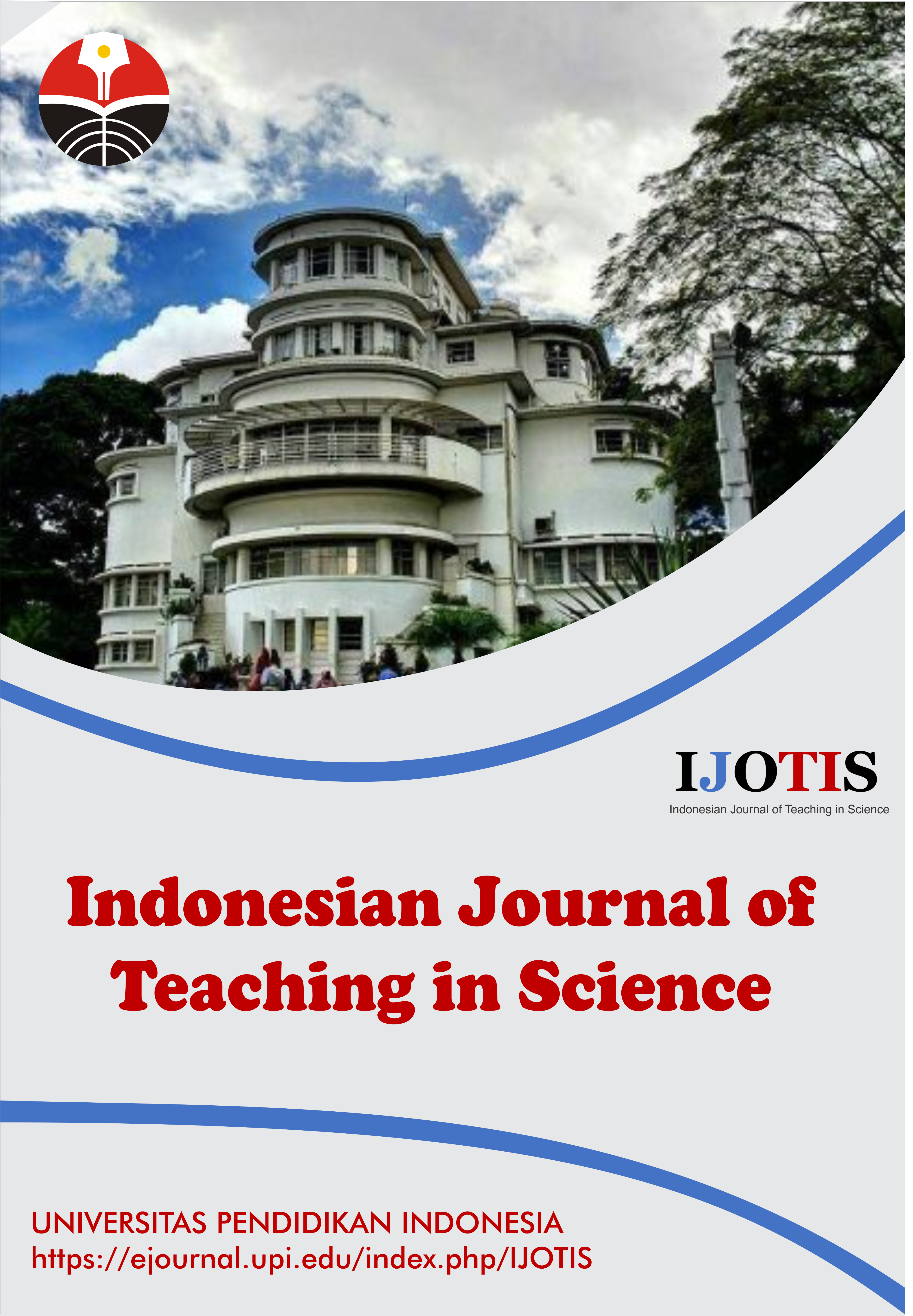Experimental Verification of the Conservation of Momentum using the Vernier Collision Cart System in Physics Education
Abstract
This study, situated within the context of physics education, experimentally verifies the principle of momentum conservation using the Vernier Collision Cart System, a high-precision tool for analyzing motion and object interactions. The research aimed to confirm that the total momentum of a system remains constant in the absence of external forces, regardless of whether the collision is elastic or inelastic. Controlled experiments measured pre- and post-collision velocities, calculating corresponding momentum and kinetic energy. In elastic collisions, both momentum and kinetic energy were nearly conserved, with minor deviations due to friction and measurement limitations. In inelastic collisions, momentum was conserved, but kinetic energy showed significant losses, primarily transformed into heat, sound, or deformation. Higher initial velocities reduced the relative impact of friction, improving accuracy. The findings validate Newtonian mechanics while demonstrating the pedagogical value of modern measurement tools in enhancing engagement, conceptual understanding, and practical skills in teaching and learning physics.
Keywords
Full Text:
PDFReferences
Abosede, P.J., Onasanya, S.A., and Ngozi, O.C. (2024). Students self-assessment of demonstration-based flipped classroom on senior secondary school students’ performance in physics. Indonesian Journal of Teaching in Science, 4(1), 27-40.
Ahangarnejad, A. H., Radmehr, A., and Ahmadian, M. (2021). A review of vehicle active safety control methods: From antilock brakes to semiautonomy. Journal of Vibration and Control, 27(15-16), 1683-1712.
Azizah, E.V., Nandiyanto, A.B.D., Kurniawan, T., and Bilad, M.R. (2022). The effectiveness of using a virtual laboratory in distance learning on the measurement materials of the natural sciences of physics for junior high school students. ASEAN Journal of Science and Engineering Education, 2(3), 207-214.
Bryce, T. G. K., and MacMillan, K. (2009). Momentum and kinetic energy: Confusable concepts in secondary school physics. Journal of Research in Science Teaching: The Official Journal of the National Association for Research in Science Teaching, 46(7), 739-761.
Bugarso, J.M.S., Arcenas, G.L., Galigao, J.M., and Camarao, M.K.G. (2024). Difficulty of science pre-service teachers in their major courses (physics, biology, chemistry, earth science). Indonesian Journal of Multidiciplinary Research, 4(1), 145-154.
Chernyavsky, D., and Gapon, D. (2020). The relationship between the laws of conservation of energy and momentum for low speed impact of several bodies. Journal of Applied Nonlinear Dynamics, 9(2), 259-271.
Cop, C. P., Cavallo, G., van’t Veld, R. C., Koopman, B. F., Lataire, J., Schouten, A. C., and Sartori, M. (2021). Unifying system identification and biomechanical formulations for the estimation of muscle, tendon and joint stiffness during human movement. Progress in Biomedical Engineering, 3(3), 033002.
Duan, Y., and Feng, Z. G. (2017). Incorporation of velocity-dependent restitution coefficient and particle surface friction into kinetic theory for modeling granular flow cooling. Physical Review E, 96(6), 062907.
Herrera, E., and Morett, S. (2016). On the direction of Coriolis force and the angular momentum conservation. Revista Brasileira de Ensino de Física, 38, e3304.
Ibrahim, A.O. (2023). Impact of blended learning method on secondary school physics students’ achievement and retention in Lokoja, Nigeria. ASEAN Journal for Science Education, 2(2), 57-66.
Kade, A., Supriyatman, S., Kamaruddin, A., Novia, N., Supriyadi, S., and Husain, S. (2024). Exploring technology-driven simulations in practical physics: Insights into mechanical measurements concept. ASEAN Journal of Science and Engineering, 4(3), 429-444.
Lazareva, A., and Tømte, C. E. (2024). Flexible learning spaces as an arena for developing professional digital competence through small group collaboration. Teachers and Teaching, 30(4), 489-508.
Lestari, D.A., Suwarma, I.R., and Suhendi, E. (2024). Feasibility analysis of the development of STEM-based physics e-book with self-regulated learning on global warming topics. Indonesian Journal of Teaching in Science, 4(1), 1-10.
Riedel, S., Bauer, J., and Stallmach, F. (2025). Time resolved investigations of momentum, energy and work during an elastic collision. Physics Education, 60(5), 055011.
Risdianto, N.S., Atika, I.N., Muna, N., Chasanah, N., and Wahyono, D.J. (2025). Paradox of precision: Challenges with ESP32 accuracy in physics educational tools. ASEAN Journal of Science and Engineering Education, 5(1), 27-32.
Shabidinova, Z., and Mamadiyeva, M. (2025). The role of technology in enhancing student engagement in modern classrooms. Journal of Applied Science and Social Science, 1(4), 209-215.
Susilowati, N.I., Liliawati, W., and Rusdiana, D. (2023). Science process skills test instruments in the new Indonesian curriculum (Merdeka): Physics subject in renewable energy topic. Indonesian Journal of Teaching in Science, 3(2), 121-132.
Termous, H., Shraïm, H., Talj, R., Francis, C., and Charara, A. (2019). Coordinated control strategies for active steering, differential braking and active suspension for vehicle stability, handling and safety improvement. Vehicle System Dynamics, 57(10), 1494-1529.
Verniers, C., Aelenei, C., Breda, T., Cimpian, J. R., Girerd, L., Molina, E., and Cimpian, A. (2024). The double-edged sword of role models: A systematic narrative review of the unintended effects of role model interventions on support for the status quo. Review of Research in Education, 48(1), 89-120.
Wang, Q., Zhang, X., Wang, D., Cui, H., Zhang, S., and Wang, J. (2025). Numerical simulation and experimental investigation on the thermal-fluid-solid multi-physical field coupling characteristics of wet friction pairs considering cavitation effect. Applied Thermal Engineering, 260, 124955.
Wong, K. S., and Wong, H. (2022). Understanding the law of conservation of momentum in one-dimensional collisions between two objects using the velocity space approach. The Physics Teacher, 60(2), 94-96.
DOI: https://doi.org/10.17509/ijotis.v5i2.89184
Refbacks
- There are currently no refbacks.
Copyright (c) 2025 Universitas Pendidikan Indonesia

This work is licensed under a Creative Commons Attribution-ShareAlike 4.0 International License.
Indonesian Journal of Teaching in Science (IJoTIS) is published by Universitas Pendidikan Indonesia (UPI)
 Indonesian Journal of Teaching in Science
Indonesian Journal of Teaching in Science



